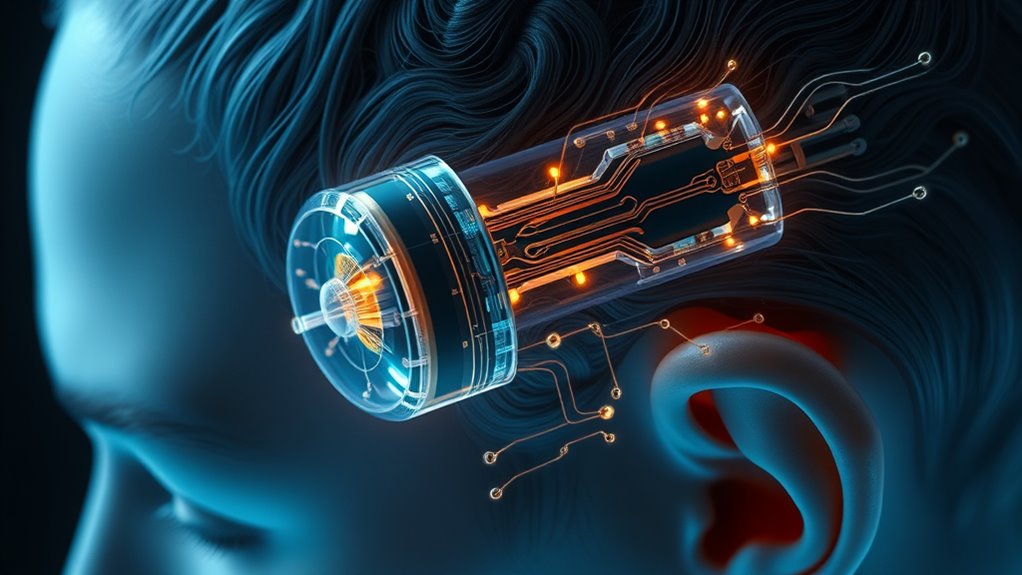Nanotech in brain-machine interfaces involves using nanoscale electrodes that seamlessly integrate with neural tissue. These tiny, biocompatible components enable you to capture neural signals with high precision, reducing tissue damage and improving long-term stability. This technology allows for more accurate decoding of brain activity, leading to better control of prosthetics and potential treatments for neurological conditions. Want to explore how these advancements could transform human interaction with machines? Keep going to discover more.
Key Takeaways
- Nanoscale electrodes enable high-precision neural signal recording with minimal tissue disruption.
- They improve long-term stability and reduce immune responses compared to traditional electrodes.
- Advanced nanotech allows for denser electrode arrays, enhancing neural activity mapping.
- Integration of nanomaterials facilitates seamless, biocompatible interfaces for brain-machine communication.
- Future applications include enhanced prosthetic control, cognitive augmentation, and neurological disorder treatments.

Have you ever wondered how tiny technology could revolutionize the way we connect with our brains? With advancements in nanotechnology, this isn’t just a dream anymore. Researchers are developing nanoscale electrodes that can interface directly with neural tissue, opening doors to more precise and less invasive brain-machine interfaces. These tiny electrodes are designed to fit seamlessly into the brain, capturing neural signals with incredible accuracy. The key is in neural signal decoding—translating the electrical activity of neurons into meaningful data that computers can understand. Traditional electrodes are often bulky and can cause tissue damage or signal degradation over time, but nanoscale electrode design offers a solution. Because these electrodes are so small, they can penetrate brain tissue with minimal disruption, reducing inflammation and scarring that often hinder long-term performance.
By leveraging the power of nanotech, you can imagine a future where brain-machine interfaces become more reliable, efficient, and accessible. The smaller size of these electrodes allows for a denser array, enabling more detailed mapping of neural activity. This means you could control prosthetic limbs with greater precision or even enhance cognitive functions by directly stimulating specific brain regions. The process of neural signal decoding becomes more refined because the sensors pick up a broader spectrum of neural activity with higher fidelity. As a result, the interface can interpret complex thoughts, intentions, or sensory inputs more accurately than ever before. These advancements could lead to breakthroughs in treating neurological disorders, restoring lost senses, or augmenting human capabilities.
The design of nanoscale electrodes isn’t just about miniaturization; it’s about creating a harmonious interaction between technology and biology. These electrodes are often made from biocompatible materials that reduce immune responses, ensuring the interface remains stable over time. Their small size also means they can be integrated into existing neural interfaces without considerably altering current procedures, making adoption smoother. Additionally, ongoing research into AI safety measures is crucial to ensure the security and reliability of these advanced neural interfaces as they become more widespread. As you follow this progress, it’s clear that nanotech’s role in neural signal decoding and electrode design isn’t just incremental—it’s transformative. This synergy of tiny engineering and sophisticated data interpretation will push the boundaries of what brain-machine interfaces can achieve, bringing us closer to seamless, natural communication between humans and machines.
Frequently Asked Questions
How Does Nanotech Improve the Resolution of Neural Recordings?
Nanotech improves the resolution of neural recordings by enhancing neural precision and signal clarity. You can place tiny nanodevices directly at neural interfaces, allowing you to detect even the slightest electrical signals from individual neurons. This precision minimizes noise and interference, giving you clearer, more accurate data. As a result, your brain-machine interface becomes more responsive and reliable, enabling better control, communication, and understanding of neural activity.
Are There Potential Long-Term Health Risks From Nanotech Implants?
You might face long-term health risks from nanotech implants, as biocompatibility concerns could cause immune reactions or tissue damage over time. Additionally, there’s the environmental impact to take into account, since nanomaterials could accumulate or disperse unpredictably, potentially harming ecosystems. While ongoing research aims to minimize these risks, it’s important to stay informed about safety assessments and regulations before widespread adoption.
Can Nanotech Enable Real-Time Brain Signal Translation?
Imagine your brain as a bustling city, with signals like cars steering busy streets. Nanotech acts as master traffic controllers, enabling real-time neural decoding with high signal fidelity. Yes, it can facilitate instant translation of brain signals, allowing seamless communication between mind and machine. This technology captures rapid neural activity, translating thoughts into commands instantly, opening doors to advanced brain-machine interfaces that could revolutionize how you interact with technology daily.
What Are the Ethical Considerations of Nanotech in Brain Interfaces?
You should consider that nanotech in brain interfaces raises significant ethical concerns, especially around privacy and consent. You might worry about how your neural data is protected and who has access to it. Consent challenges also arise, as users may not fully understand the risks or long-term effects. Ensuring transparent communication and strict regulations can help address these issues, so your rights remain protected in this rapidly evolving field.
How Cost-Effective Is Nanotech-Based Brain-Machine Technology?
You’ll find that nanotech-based brain-machine technology can be quite cost-effective over time, especially as manufacturing costs decrease with advancements. However, scalability challenges currently limit widespread adoption, making initial development expensive. As production techniques improve and economies of scale kick in, these costs are likely to drop, making the technology more accessible. This progress could eventually lead to broader use and significant benefits in medical and technological fields.
Conclusion
You see, nanotech not only nurtures new neuro-networks but also traverses nuances of neural necessity. By bridging boundaries between biology and technology, it beckons a bold, brain-bound breakthrough. As you consider the countless capabilities, remember that this tiny tech transforms thoughts into tangible, tangible truths. Embrace the evolution, for nanotech’s natural nuance nurtures a new neural network, navigating the nexus of innovation and intelligence.









